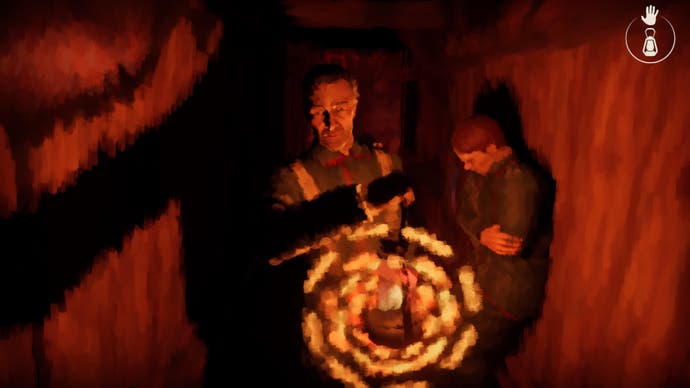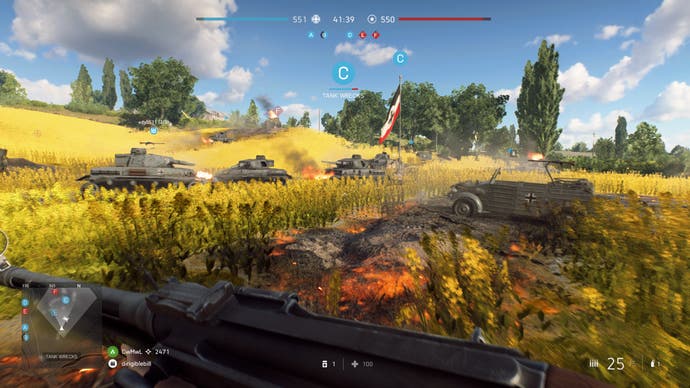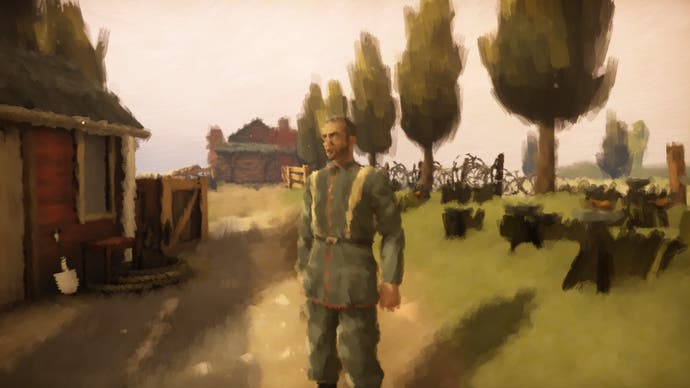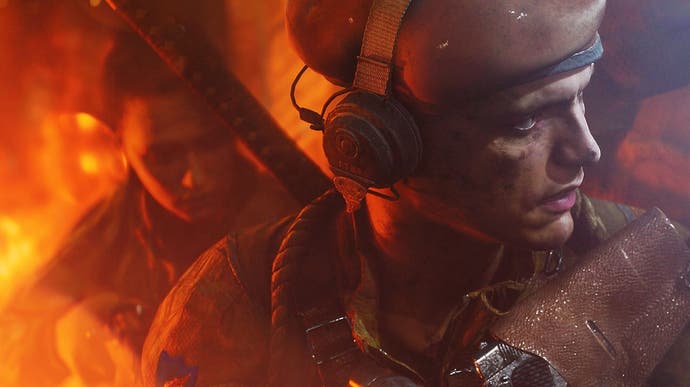What should a World War look like?
Copying reality, making history.
Video games have given us countless images of the past, some literal-minded, some more playful, from Total War's continent-sized thought experiments to the hinterland between myth, game design and archaeological record that is Assassin's Creed Odyssey. Among 2018's offerings are two that, to my mind, deserve special attention for the stark yet deceptive contrast they form: DigixArt and Aardman's melancholy Great War tale 11-11: Memories Retold, and DICE's characteristically seismic World War 2 shooter Battlefield 5.
In many respects, the two could not be more unlike. One is a multiplayer-centric ensemble piece in which huge armies clash on a Greatest Hits of regional combat theatres, the other a gentle, affecting third-person outing in which you need never fire a single bullet. Each game, moreover, has its own very specific way of looking at the past. One is a photorealistic simulation, devoted to visual granularity both for its own sake and to facilitate encounters in which cover and camouflage are key; the other, a playable homage to fine art and in particular, the late 19th century movement Impressionism, which "paints" each frame's contents in real-time, brushstroke by brushstroke.

Consider how their approaches differ when it comes to objects near and far. In Battlefield 5, everything is knife-sharp no matter the distance, as you zero-in on bodies crawling along a hillside only for an opposing soldier to burst, horribly gigantic, from the undergrowth to your left. Visibility varies according to the weather and combat conditions, but the ethos remains one of baleful clarity: the grenade smoke might block your aim but it is always high fidelity. 11:11 has no truck with such all-or-nothing detailing - indeed, it seems positively hostile to it, at any range. Lanterns, branches and barbed wire shudder apart close at hand into writhing columns of brushmarks, like dirty raindrops on glass, while landmarks are swept away and etherised in heaves of autumnal colour.
If these are very different games, and very different ways of visualising the past, Battlefield and 11-11 share an understanding that history is always made, not transmitted. Both appreciate that the past is the product of selective citation, and both express a healthy antagonism towards certain monolithic accounts of their chosen periods. Amongst other "untold stories", Battlefield's episodic narrative includes tours in the shoes of black Senegalese soldiers whose feats were white-washed by the French army, while 11-11 is a rare opportunity to visit the German domestic front in a genre that seldom travels further eastward than the Somme. But Battlefield's questioning of history's construction does not extend beyond the frame to its own means of representation. By contrast, 11-11's unstable aesthetic is an on-going self-critique of its ability to recall the events depicted.

If the aim was, as one producer told me during a preview showing, for 11-11 to resemble an oil landscape when paused, the effect in motion is of continual erosion and recomposition - a process that is by turns beautiful and ugly, but always very provocative. It embraces the "unfinished" feel of much Impressionist art, in which fleeting effects of light are layered in such a way as to fix attention at the surface of the canvas (famously, the Impressionists named their movement after a satirical review by the critic Louis Leroy, which likened Claude Monet's Impression: soleil levant to an early sketch for a wallpaper pattern.) What's more, 11-11 performs that self-critique at the level of core mechanics by having each character wield an apparatus of representation in turn, and challenging you throughout to leave a faithful record in a propagandist era. As Harry the Canadian war photographer, you choose to send rosy or less-rosy pictures home to your sweetheart, in between rousing shots of your boorish commanding officer. As German signal officer Kurt, you compose letters to your daughter from a phrasebook of morbid or uplifting sentiments and those somewhere in between.
Battlefield 5 has no equivalent for this, in large part because celebrating its own mind-bogglingly expensive Frostbite technology is more the point than fashioning some kind of permanent historical exhibit. The game's story might decry the agendas of other chroniclers, at one point showing black soldiers disappearing from a group photograph as their accomplishments are scrubbed out by the censor, but it cannot afford to offer its own frame the same scepticism. The World Wars are done deals, after all, whereas Frostbite games are still on shelves, and if those glistening multiplayer maps seem more solid and enduring than 11-11's ceaselessly repainted scenes they are, in fact, more ephemeral - doomed to be superseded by next year's Frostbite games, each "realler" than ever before.

Given the hours of labour involved in creating the associated assets, there is something quietly atrocious about the way so much of Battlefield's splendour exists simply as interference - white noise, however appealing to the eye. The game's visual sophistication is designed to make you better at filtering out such sophistication, better at ignoring distractions - a more efficient sieve for the threats and variables that lurk within the bounty. As Joshua Casteel, a US combat veteran, writes in a terrific essay on Call of Duty: Modern Warfare 2, games of this kind want you to "see" rather than "look", to perceive actionable features over nuance. "If you stop too long to look, trying to spot the visual differences between a ski mask and a kefia, you're done," he observes, comparing Call of Duty's marine training course to memories of his own tour of duty. "You gotta just see, like you're seeing with your stomach, so you're not looking, you're seeing, and once you're seeing, you're firing, which means they're dead and you're not. You can't trust details." Battlefield's graphics technology is, in other words, strangely but symbiotically at odds with Battlefield as a work of design.
It would be easy to conclude by giving 11-11 a pat on the head for not being Battlefield, but that's to be a little too harsh on Battlefield, and a little too generous to 11-11. For one thing, Battlefield's photorealism is only one component of its aesthetic. The aim may be to capture reality's texture as closely as possible - "closeness" is a term that features often in Frostbite marketing materials - but the maps are nonetheless compositions, not copies, subject to a bespoke mood palette and rife with "painterly" touches. On the mountainous Fjell 652 map, yellow parachutes form great, billowing sunflowers around the peak that routinely hypnotise me as I run from objective to objective, calling to mind the carefully calibrated spectrum of DICE's Mirror's Edge games. And if Battlefield's environments owe more to a photorealist painter like John Baeder than Manet, the influence of impressionism among other, less literal traditions can be discerned in the streaking, strobing colours of the franchise's key art.

More importantly, though, 11-11 actually shares many of Battlefield's troubling core values. You could argue that it is, frankly, just as in love with its own technology's representational capacities. It's just that rather than trying to duplicate the material reality of an event, 11-11's simulation is trying to imitate a species of painting, and the choice of which paintings to imitate has roots in the blockbuster industry's worship of the photoreal and technology unto itself. As I learned during my preview session, Aardman and DigixArt discussed a number of traditions as inspiration for the game's look, amongst them the madcap, discombobulated machinery of Futurism. The latter is arguably the more appropriate point of reference than Impressionism, given that Futurism dates from the World War period and many Futurists compositions actually channel the experience of battle: certain members of the movement, including its notional founder, Filippo Tommaso Marinetti, even worked as wartime propaganda artists. The developers feared, however, that Futurism's artful crudities and dizzying abstractions might have seemed merely "cheap" to a modern gamer weaned on the glories of a game like Battlefield.
History is often more about justifying the present than exploring the past - about seeing in what was the inevitability of what is and so, planting the seeds of today's values in events that might have taken a different turn. In the case of video game histories, the supporting technology has a way of infiltrating the notion of history itself, flattening it into spectacle. Rather than gathering details into narratives that explain our current moment, history in games is simply detail, because representative technology does not, we are told, construct or abet narratives - it merely reflects. For all its compromises, 11-11 tackles this falsehood head-on by presenting its aesthetic as forever under construction, and surfacing the technologies that make history as part of its story and range of action. It puts the camera in front of you, in short, and asks you what it's for. In Battlefield 5, its subversive moments notwithstanding, the camera is the one detail you never see.

